Patio surely gives you extra living space. That’s the best way to enjoy some time outside despite the weather.
Basically, the patio itself is an extension of your home. But, what about extending it a little bit more?
Sometimes, a patio doubles up as a front porch.
Why settle for less if you can increase your curb appeal by extending your patio?
- Simple Patio Extension Idea Using Concrete
- Unique Patio Extension Idea with Slices of Several Trees Laid Flat and Gravel
- Concrete Overlay as an Extension of a Classic Concrete Patio
- Traditional Patio Extension Idea Using Bricks
- Stone Slab Patio Extension with no Cover
- Combination of Stone Tile and Concrete Patio Extension Idea
- Concrete Slab with Gravel to Fill the Space in a Patio Extension
- Minimalist Patio Extension Idea Using a Large Slab of Concrete to Match the Main Patio
- Round Gravel Patio with a Fire Pit as an Extension of a Brick Patio
- Large Light-colored Concrete Patio Extension with an Umbrella
- Stone Tile Patio Extension with Brick Edging Completed with an Outdoor Fireplace
- Circular Shaped Concrete Patio Extension with no Seating Area
- Tiled Patio Extension Detached from the Main Covered Patio
- Spacious and Half-covered Patio Extension Installed Next to the Deck
- Patio Extension Connect the Covered Porch to the Poolside
- Freeform Patio Extension to Create a Pretty Border for the Main House
- Patio Extension Materials if You’re on a Budget
Patio extension is beneficial. You can create more space for a seating area or build a playground for your kids to roam around the outdoor living space.
Either way, the idea of creating a patio extension is practically endless. To point out the contrast, you can use a different material from the main patio. This will add more characters to your area.
On the other hand, if you want to create a consistent look, you can use similar material, so it looks as if your patio has been built on a large scale in the first place.
You can add a cover if you like or leave it uncovered if you’re on a budget.
To help you choose the right look, here are 15+ cool patio extension ideas that may give you some inspiration to do some remodeling:
1. Simple Patio Extension Idea Using Concrete

This backyard patio is an excellent example of a transitional style.
The soft and neutral color palette makes it look luxurious yet minimalist at the same time.
The main patio is situated right on the backside of the house. It is completed with an outdoor kitchen and an outdoor living room.
However, we can see that the bar needs more space. That’s why the homeowners decided to extend the patio.
The patio extension is quite big, and it seems to be made of concrete instead of tile. Yet, the concrete was stained to match the color of the tile, so overall, this patio looks cohesive and consistent.
The patio extension is used to place the bar stools that are put right in front of the bar.
Since this is an L-shaped outdoor kitchen, the bar stools need to be placed following the bar’s line and design. That’s why the extension is needed to accommodate the stools on another side of the L-shaped bar.
To deliver more comfort, the patio extension is covered with a pergola. It’s not a fully covered area like the main patio, which is completed with a roof extension. But that makes it a great place to soak up the sun, but at the same time, you’re still shaded.
2. Unique Patio Extension Idea with Slices of Several Trees Laid Flat and Gravel

Don’t think that the homeowners cut down all those trees. It may appear so, but it’s actually slices of several trees laid flat in this patio extension.
This is a unique and unusual look, the kind of patio extension idea you should go for if you like something different. It seems that these are pre-cut trees.
Actually, this patio extension can also be used as a no-plant landscape. Even without a seating space, this extension looks extra. It’s clear that the homeowners want to make this area a focal point.
The patio itself is made of simple concrete in light gray color. Look how it contrasts the slices of trees prettily.
In each space of the trees, the homeowners filled it with gravel. The combination of gravel and slices of trees create art right in the backyard.
If you want to make an artsy patio extension like this:
- Make sure you don’t overwhelm it by adding too many decorations and bold chairs to attract more attention.
- Keep this area clean and minimalist.
- Let the unique materials create a statement.
3. Concrete Overlay as an Extension of a Classic Concrete Patio

It seems that this patio extension is made of a concrete overlay. It’s a few inches lower than the main patio that has a roof extension as a cover.
The main patio appears to be made of usual concrete that keeps the traditional look. There’s a seating space that may be sufficient for some but not for others.
It looks like the homeowners thought that one seating space wasn’t enough.
Why waste a large backyard with a landscape if you can extend the patio? That’s why the patio stretches out to the lawn.
The concrete overlay makes it look as if it was made of gravel, but that’s the most beautiful part. It creates a contrast to the mown grass around.
There’s a seating area right in the middle of this patio extension. This is an outdoor dining space, which is a good thing if you install an outdoor kitchen on the main patio.
There is no cover in this patio extension, which means that you can only enjoy it in certain months and seasons. No problem, though, as long as you’re able to enjoy summer days and nights outside.
4. Traditional Patio Extension Idea Using Bricks
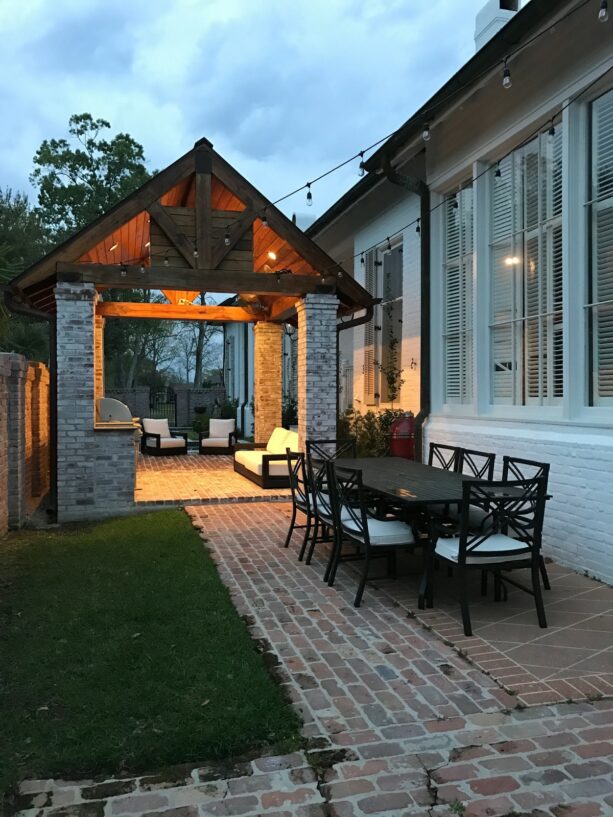
This traditional patio doubles up as a gazebo. It has a gable roof as a cover, complete with a couch and chairs to provide comfort.
This patio looks solid and strong, with four brick columns supporting the roof.
This is surely the best spot if you want to enjoy some time outside without worrying about the weather.
However, the homeowners wanted to add something more. Instead of creating a landscape, they extended the patio to the side of the house.
This patio extension has no cover, but it’s also completed with a seating area. It seems that this is an outdoor dining area with a long dining table and eight dining chairs. What a huge spot to accommodate a big family eating outside.
In order to keep the traditional look, the homeowners used a brick to extend the patio. Yet, the inner area of this patio extension is made of tile and edged with bricks.
The brick edging is laid differently from the bricks in outer space. Both create a contrasting look but are barely noticeable because the tile and the bricks are in a similarly soft color.
There’s a string of light hung above this patio extension to illuminate this area and create a warm and cozy space at the same time. It’s placed side by side with the lawn, so the contrast is quite prominent.
5. Stone Slab Patio Extension with no Cover

This is another patio extension with no cover.
The main patio doubles up as a porch, completed with a roof to protect the furniture. It appears that the main patio is used as an outdoor kitchen. It also features an outdoor dining space. It is made of stone tile with a light color to create a traditional look.
The patio extension, on the other hand, looks more natural. It is also made of stone, but instead of tile, it’s a stone slab cut in a perfect rectangular slab.
The slab was laid with a space to each other. And each space is filled with grass. The combination of stone slab and grass delivers a perfect timeless look. This is what makes this extension area looks natural.
Even though it has no cover, that doesn’t make this area any less comfortable. The rattan chairs were added to provide comfort. It seems that this patio extension is used as a place to accommodate an extra seating space that’s more open to the view outside.
Surrounded by a landscape, this is a perfect example of a traditional and natural patio extension.
6. Combination of Stone Tile and Concrete Patio Extension Idea
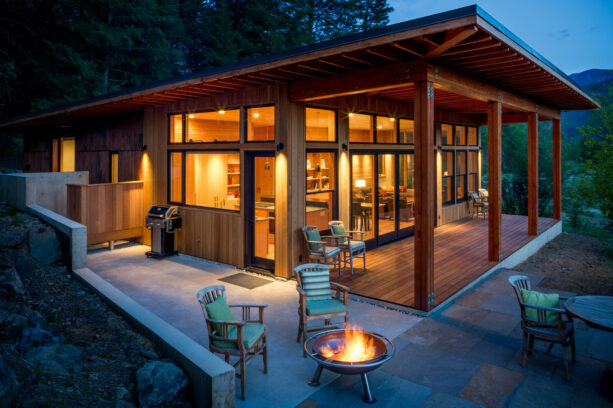
This is a rustic house. So, no wonder wood is the dominant element used in this house, including the main patio.
The wooden patio looks like a deck. It’s completed with two sets of chairs to accommodate four people.
Since this backyard is spacious, the homeowners decided to extend the patio. The patio extension has no cover, but it surely looks as comfortable.
This patio extension stretches out the side and the front side of the main patio.
The great thing is that the homeowners used two different materials to extend the patio. The combination of stone tile and concrete patio contrasts the wooden main patio.
The side of this patio extension is made of concrete. It appears that this area is used as an outdoor kitchen because there’s a gas grill there.
The stone tile and the concrete area have no border, so they just blend seamlessly despite the difference.
The homeowners placed a fire bowl in the transition area with two chairs around. There’s another seating space in the stone tile patio extension to complete the whole look.
A lot of seating spaces in this patio, the main and the extension, make this area a perfect spot to host a garden party.
Surrounded by the landscape with a breathtaking view, this patio extension will give the best experience of eating outside.
7. Concrete Slab with Gravel to Fill the Space in a Patio Extension

If you have a spacious patio area and you want to show elegance and a luxurious look, you can go for this style.
The main patio has a black stained Hardi siding put in a board and batten fashion. The T&G cedar ceiling in a clear seal is completed with recessed lights and fans, making the whole atmosphere warm, cozy, and inviting.
Actually, the main patio ends where the medium walnut stain posts stand. Yet, the homeowners extended it to add more character to this patio and improve the whole look of the exterior.
The patio extension is made of concrete slab with gravel to fill the space. Each concrete slab was cut in a perfectly square shape, and they were laid in a similar space between each other.
The dark gravel contrasts the light-colored concrete slab. This area is basically a statement. So, no need to add a seating space anymore. Seating areas will only hide the beauty of this combination.
Instead of a seating area, you can install a metal planter box like this as a minimalist and natural decoration.
8. Minimalist Patio Extension Idea Using a Large Slab of Concrete to Match the Main Patio
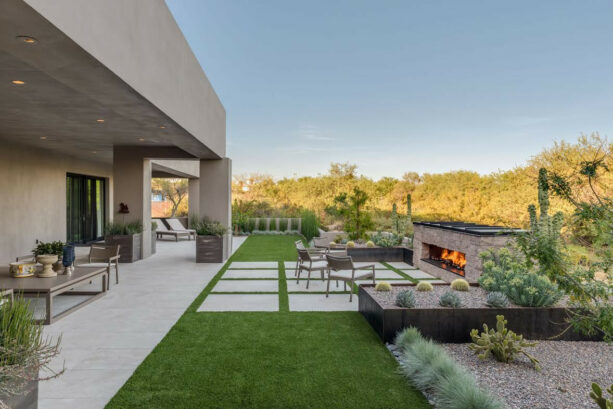
Simple and minimalist are the two keys to creating a modern look.
Forget about bold and statement decoration if you want to achieve a modern look. This patio extension is no different. It’s clear that the homeowners wanted to keep everything minimal, simple, yet luxurious.
The whole patio area has a light color palette. No contrasting color was added. The one and only opposite element is the green lawn around.
Actually, the main patio with a cover doesn’t lack seating space. It is completed with a metallic table and chairs.
However, it’s quite impossible to install a large fire pit there. That’s why the homeowners installed a patio extension to accommodate the fire pit.
It’s clear that the homeowners intended to go big with the fireplace. They made it more like an outdoor fireplace instead of a fire pit.
This is the best spot to have a roasted marshmallow with friends and family on summer nights. There’s a seating space right in front of the fire pit to provide more comfort.
The patio extension itself is made of a large slab of concrete. Using a large slab of concrete is meant to match the main patio, which also seems to be made of concrete.
But, instead of using poured concrete, the homeowners decided it would be better to use a large slab of concrete with grass in each space to make it blend more seamlessly with the lawn.
9. Round Gravel Patio with a Fire Pit as an Extension of a Brick Patio
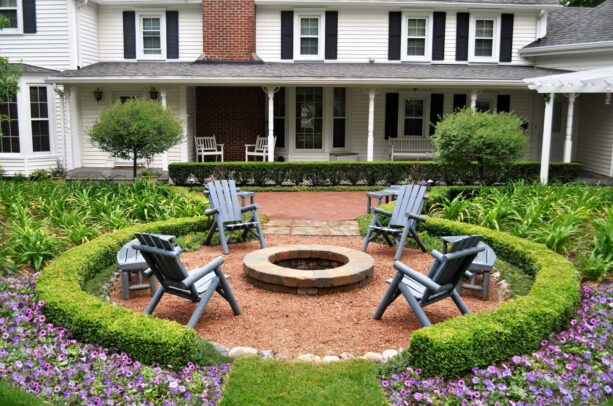
The main patio of this house is made of brick, similar to the walkways. This is a lovely farmhouse landscape that features yew hedges and boxwood.
Unlike the usual patio and its extension, where the main patio is completed with furniture, this one is quite the opposite. The main patio that’s made of brick is free from any furniture. It looks plain and bland; maybe it’s used as a playground.
On the other hand, the patio extension is completed with Adirondack furniture and a round fire pit. This extension is round, too, and surrounded by annual flowers.
The red ground you see here is decomposed granite, which is actually gravel. Decomposed granite is an excellent surface for casual settings. Apart from having to rake it regularly, this one makes a perfect ground cover.
There’s a stone edging around to separate this patio extension from the plants around.
The main and the extension patio is separated by what seems to be a stone slab. Stone slabs in the middle of bricks and gravel will deliver a decorative look that ties everything together.
10. Large Light-colored Concrete Patio Extension with an Umbrella
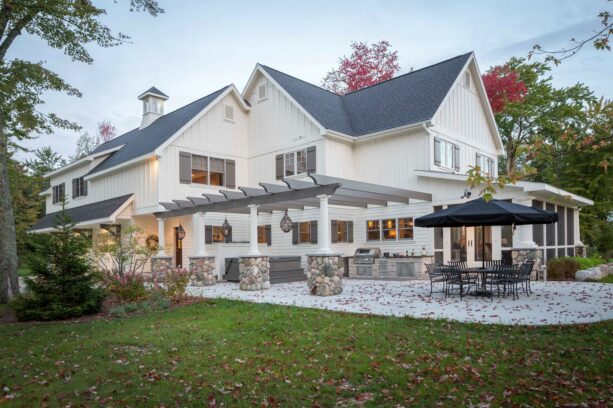
The main patio is a pergola in this backyard.
Actually, this large area has no cover. Yet, in order to provide shade during the hot summer days, the homeowners thought it would be great if they installed a pergola.
This is a more affordable and simpler way to give comfort during the hotter months than a roof extension.
The main patio is used as an outdoor kitchen. Even though space is not a problem here, the homeowners prefer to keep the outdoor kitchen area free from any seating space. Maybe it’s to make sure that people can move more freely.
The patio extension was added to accommodate a dining area. This whole patio may have no cover, but that doesn’t mean that the owners want to be bothered with the weather. They came up with a great idea to provide shade easily: a sunbrella.
Sunbrella is an umbrella that’s meant to block the sunlight. The built-in table in the sunbrella is enough to make it a dining space. It’s also completed with dining chairs around.
Since this is a traditional look, everything should be as conventional as possible.
See how the light-colored concrete complements the white siding of the house. Even the pergola, the sunbrella, and the furniture were carefully picked in a neutral color to emphasize the traditional look.
11. Stone Tile Patio Extension with Brick Edging Completed with an Outdoor Fireplace
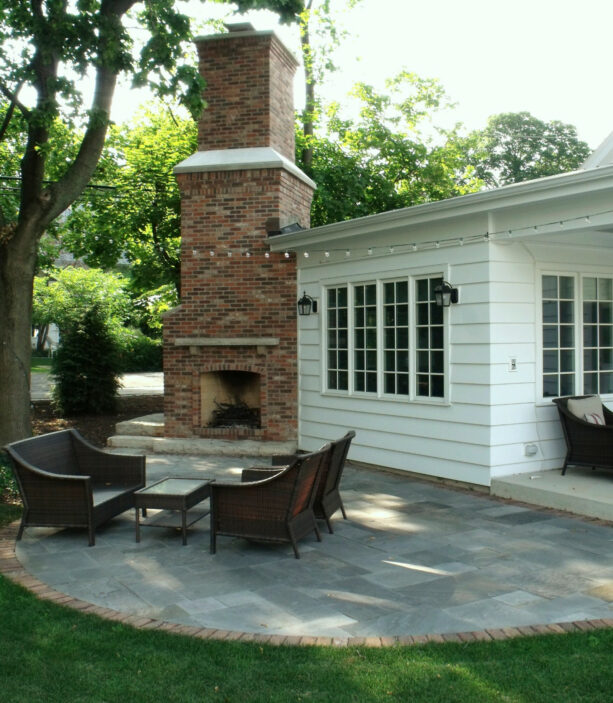
This is also another example of a traditional patio. This one is smaller, though.
The main patio is raised, which seems to be made of poured concrete. One step lower, there’s a patio extension that’s made of stone tile. This half-circular-shaped patio extension was added later to accommodate a corner outdoor fireplace.
With such an outdoor fireplace, this patio extension is surely more popular than the main one during the colder months. On the contrary, the homeowners can still enjoy the view outside on the covered main patio on rainy days.
That’s one reason why you should have a covered patio and its coverless extension. This way, you can choose which area to sit in depending on the season and the month.
The stone tile patio extension looks more attractive than the main patio. We can’t deny that stone is more expensive than concrete, yet it looks prettier.
So if you’re on a budget, it’s better to use the costly stone tile in the extension area, which is supposed to be smaller than the main patio. You can get the beauty without sacrificing your money.
Moreover, this tiled stone area is edged with brick. Such a combination will never fail to give you a vintage look. This area sits right next to the lawn. So the green grass provides a lovely and natural contrast to the stone.
12. Circular Shaped Concrete Patio Extension with no Seating Area
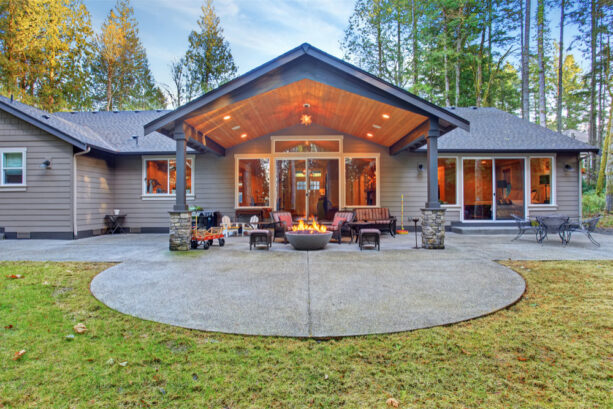
This patio extension is also shaped circular.
However, it remains unclear what’s the use of this patio extension since it’s not completed with anything. It’s just bare, plain, and empty.
Perhaps it’s used as a playground or a space extra space that can be used for anything. Either way, this extension adds more balance to the entire landscaping.
This craftsman-style patio is quite large. It features a lot of seating spaces that can accommodate many people at once.
The main patio is covered by a gable roof, and it seems that this area blends with the front porch.
In this covered patio, there’s a fire pit surrounded by chairs, along with couches, stools, and Adirondack furniture, a perfect spot to hang out outside.
The patio is extended to the left, right, and front.
On the right side, this area features a set of tables and chairs. This provides a more open area where the owners can enjoy the view outside more freely without any cover.
From this angle, we can see that this patio extension’s left and the front area remains empty. It leaves more possibilities for the owners to decorate them.
13. Tiled Patio Extension Detached from the Main Covered Patio
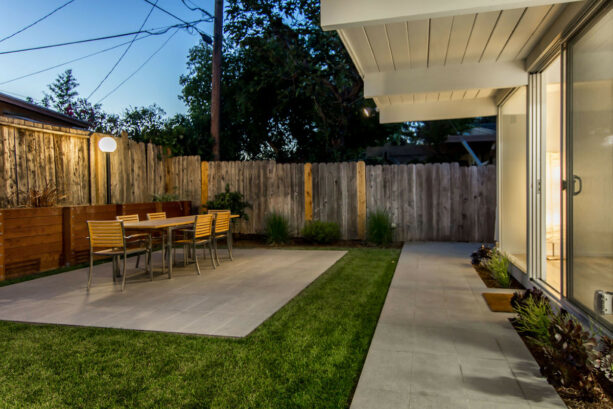
It may look like concrete, but this is actually a tile. Both the patio and the extension area are made of tile with a gray color that mimics concrete.
The main patio is long and narrow, so it’s impossible to be added with large and comfortable furniture.
This area, however, has a roof extension. Instead of seating space, the homeowners installed a built-in garden on this main patio. The lack of seats makes it possible for the plants to absorb more sunlight.
The seating space is added to the patio extension. Unlike previous pictures, this extension area is detached from the main one. There is no walkway or steps to connect them both.
This patio extension is surrounded by the lawn, making it look stand out against the green canvas.
The homeowners styled the patio extension simply and in a minimalist way. They only put a dining table along with the chairs. The round pendant illuminates the whole area with a soft and warm glow.
The simplicity of this patio, along with its extension, makes it a perfectly modern look. The only decoration is the plants and wooden planter boxes attached to the wood screen.
14. Spacious and Half-covered Patio Extension Installed Next to the Deck
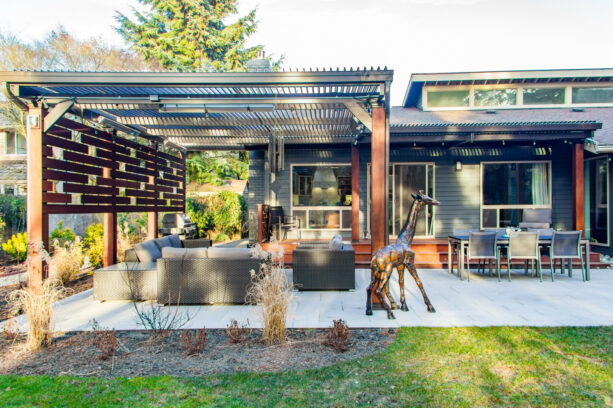
Having a large backyard is beneficial. You can experiment with a patio design as well as landscaping.
Building a patio and designing a landscaped side by side is possible. There’s even a deck that connects to the entire patio.
The deck and the main patio are perfectly covered with a transparent roof supported by wooden posts. It appears that the main patio is also a pergola.
Either way, this is a perfect outdoor seating space that’s also completed with a wooden screen to guarantee privacy.
The cover enables the owners to sit here despite the rainy days. That’s why the furniture pieces look more luxurious and heavier. They’re not simply chairs. There are couches and sofas in this area.
On the other hand, in the patio extension, the furniture is simpler, and it’s obviously meant to be an outdoor piece. It’s a dining table along with the table that completes the look of the outdoor kitchen at the back of the main patio.
The patio extension is partly covered by the roof extension that’s meant to shield the deck.
The rest of the extension area remains open and bare. This way, people can move freely, and the owners are free to experiment with the decoration.
15. Patio Extension Connect the Covered Porch to the Poolside
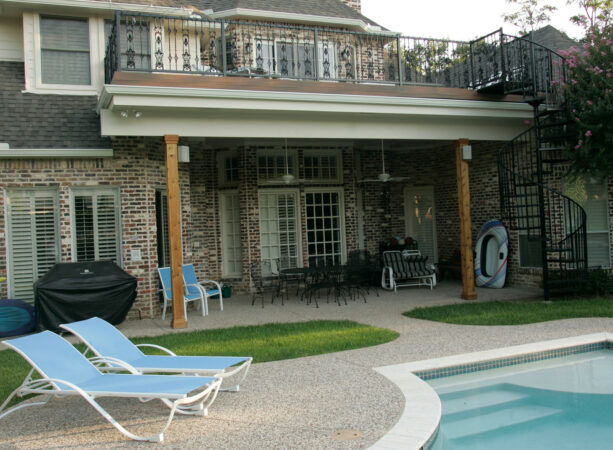
The main patio is right under the deck.
The deck appears to be on the upper level of the house, so the space below can be utilized as outdoor seating space.
As a covered patio, this one is completed with a large number of seats, from usual chairs to unique double chairs. People can choose the spot they want to spend some time in.
Actually, the main patio ends where the posts stand. But the homeowners wanted to extend it, so the patio and the poolside are connected.
In order to make the connection more seamless, the material is similar. Both the patio and the extension area are seemingly made of tile that looks like gravel.
It’s not recommended to use real gravel for such a huge area because it would take much of your time to rake it regularly and keep it stay in place.
The small path connects the main patio and the patio extension. The path is also made of tile to create cohesion. The path is surrounded by mown grass, which makes it as if the path breaks the lawn into two.
The patio extension is completed with lounge chairs because this area is basically poolside. Perhaps the reason why the owners extended the patio is so it can blend seamlessly with the other areas in this backyard.
16. Freeform Patio Extension to Create a Pretty Border for the Main House
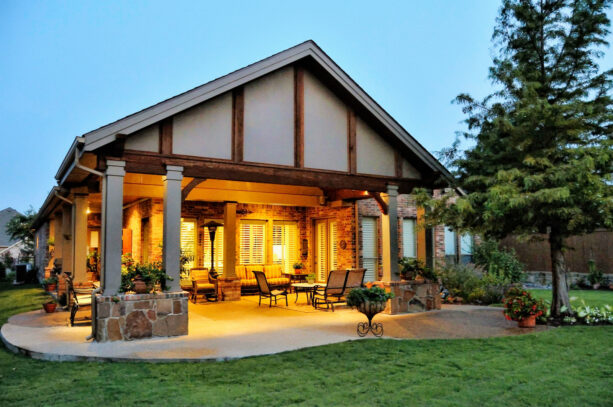
The unique thing about this patio extension is that it’s not used to accommodate extra seating space or provide a more open seating area. Instead, this area is used to create a pretty border to the main house.
Look how the patio extension doesn’t follow any certain shape. It is shaped in a freeform design to create a more whimsical look. The patio seems to overflow but in an aesthetic way.
The extension area is also not that large, so it’s not reasonable to add any furniture here.
All the seating spaces have been added to the main patio, which is perfectly covered with a gable roof.
The extension is only used to accommodate some potted plants that are strategically placed to add a more natural look to this craftsman patio.
In a certain spot, the patio extension is a bit higher than the rest of the landscaping, which adds more dimension to the house’s entire look.
The patio and its extension are made of concrete, which contrasts with the lawn around.
Basically, this is not a new look. Contrasting concrete and green grass are way too common. What makes it different is the freeform design.
17. Patio Extension Materials if You’re on a Budget
If money is quite a problem here, don’t fret. You’re still able to extend your patio in the most affordable way.
Here are some best materials you can choose that won’t make you break the bank:
- Packed Gravel. This is the best choice when it comes to affordability and easy installation. You can use landscape edging, like bricks or treated wood, as a border to keep the grass stay in its place and not encroach on the patio. Line the area with fabric to let it drain and block the weeds prior to spreading the gravel. Cost estimate: $560. Time estimate: 1/2 day.
- Crushed Stone. Actually, this is something that people usually use as a base material for pavers. However, it turns out that it can make a great patio extension. After being tamped down and wetted, it becomes a solid surface. This is also the best option if you intend to lay pavers later. Cost estimate: $430. Time estimate: 1 day.
- Pavers. After the base materials have been laid, tamped, and wetted and the solid surface has been formed, you’re ready for the pavers. Keep in mind that pave stone pavers have various patterns, sizes, and materials. Lay out the pavers in a pattern you like. Don’t forget to top it with topping sand to keep the pavers in place. Cost estimate: $1,560. Time estimate: 2 days.
- Concrete Forms: The recommended product for concrete forms is WalkMaker from Quikrete. It makes a good patio extension. Even though basically it’s concrete, concrete forms can be made to mimic stones or bricks. You can even customize it to add color or stain to the concrete mix after it has dried. Cost estimate: $1,480. Time estimate: 2 days.


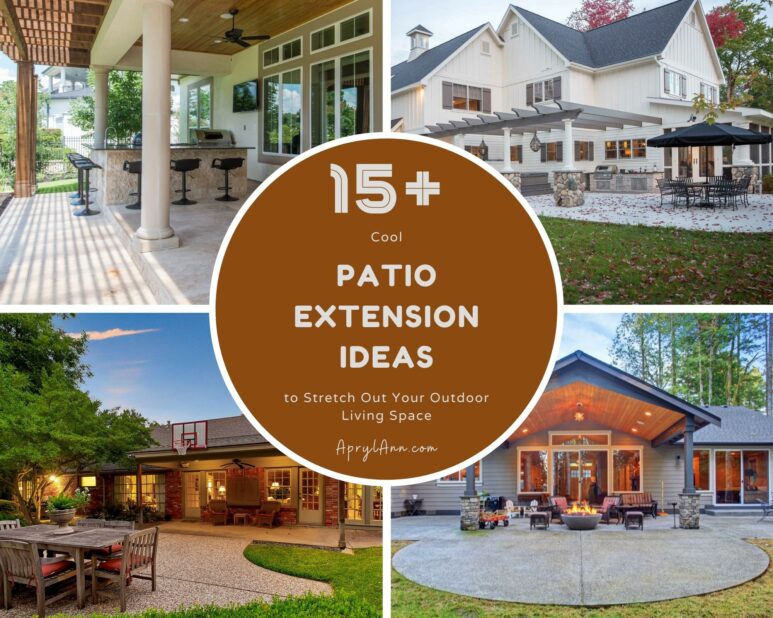
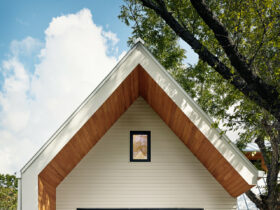
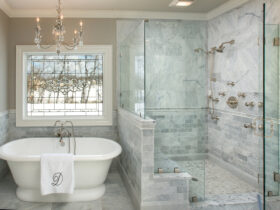
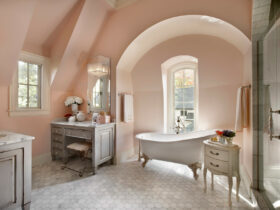
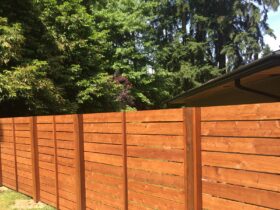
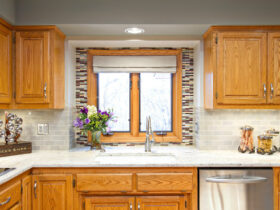
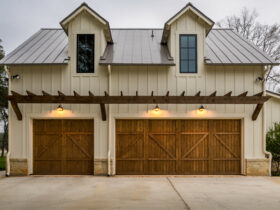
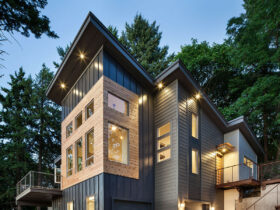
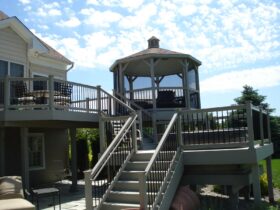
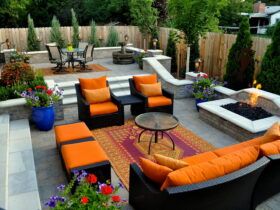
Leave a Reply
View Comments